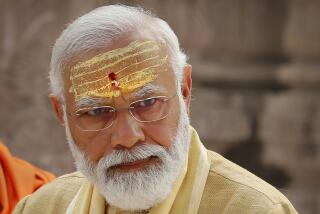The India Problem: A Matter of Multiculturalism : Nationality: Tearing down a mosque becomes a boundary-marking statement of political dominance in a land torn by Muslim-Hindu strife.
- Share via
NEW YORK — Last Sunday, a mob of Hindus descended on an old mosque in the north Indian town of Ayodhya and tore it apart with picks, crowbars and their bare hands. In its place, they began to construct a temple consecrated to Rama, the god-king hero of Hindu mythology. During the following days, in towns and cities of India, Pakistan and Bangladesh and even in Britain, shrines, shops and houses have been destroyed. At least 700 people, probably many more, have been killed in India.
Murderous conflicts based on religious or some other cultural identity are not new, nor are they confined to India. The fall of the Soviet system brought old questions of national identity back to the forefront of international politics.
In a world increasingly hostile to a multiplicity of cultural perspectives, where constructions of linguistic, religious and historical uniformity have steamrolled over the messy juxtapositions of diverse ways of life, all nations are moving toward a common, interchangeable model with just a small repertoire of flags and monuments to mark off the boundaries. Among large countries, only India and the United States survive as possible alternative political assemblages, embattled in the face of worldwide forces of uniformity.
Since independence in 1947, India’s dominant national ideology, most forcefully articulated by its first prime minister, Jawaharlal Nehru, attempted to find space for a historically dynamic and richly various political community. Reduced to tired cliches, “unity in diversity” and “secular society,” such a vision has had limited powers to command the energies of India’s vast population toward a vision of a common cause.
In a land of frustrated ambitions, leaders have sought to organize support around more defined lines of identity. Rama, as a symbol of the Hindu nation, is one. In the Indian past, rulers and would-be rulers have torn down religious shrines and put up new ones to mark out their claims to political dominance. Hindus have pulled down Hindu shrines, Muslims have destroyed Hindu temples--and also had new ones built.
The Babri Masjid was built in 1528, to mark the Mughal conquest of India, probably on the former site of a Hindu temple that may have been dedicated to Rama. Its destruction, on Dec. 6, was an attempt to mark a new conquest, the conquest of a pluralist polity called India by those who would have it reduced to a culturally monolithic nation-state. The Holy Roman Empire, as E.M. Forster’s enlightened Englishman says at the close of “A Passage to India,” is now to join that sorry, 19th-Century sisterhood of little, small-minded countries.
There is no complicated theological content to the exultation of Rama as a national symbol. For current political purposes, Rama serves as a kind of Joan of Arc or George Washington. More to the point, he is not Mohandas K. Gandhi, who was assassinated in 1948 by a member of the militant group that has been behind the movement to make India a Hindu nation.
To identify a particular place with a particular event, say the birth of a national hero, is an act of standard, European-style historical thinking--one event following another in the unfolding of a nation’s past, not the infinitely richer cosmic notions of cyclical time and multiple levels of reality that characterize serious religious reflection among Hindus. Tearing down the Babri Masjid to erect a temple to Rama is a marker of social boundaries, an attempt to exclude at least 20% of India’s population from full citizenship. Those who have sponsored this movement over the last five years are seeking political and economic advantage.
P.V. Narasimha Rao, India’s elderly and much compromised prime minister, who allowed this event to take place by not taking action to prevent it, made his political debut as a teen-ager in the old “princely state” of Hyderabad, ruled by a Muslim dynasty of British puppets. He was arrested for singing the Hindu nationalist song “Banda Mataram,” originally written by the 19th-Century Bangali writer and embedded in a historical novel depicting Hindu resistance to Muslim rule. The song depicts India as a Hindu mother goddess. It now begins each broadcast day on the national radio station. It says to non-Hindus that India is not their country. Indian history becomes the story of a unified people beset by waves of invasions but ever loyal to a common heritage.
Now there is evidence that numerous Indians, even those who unleashed this Hindu nationalist movement as well as those who felt a less impassioned sympathy for its simplified interpretation of India’s history, have recoiled from the horror of the toppled mosque and the widespread killing. Rao has said the mosque will be rebuilt.
To maintain the authority of Indian Supreme Court decrees and the credibility of the rule of law, those who have started to build the temple on the site of the mosque cannot be allowed to prevail. Perhaps what India needs is a memorial to the hundreds of thousands of people who have died as a result of the ambitions of politicians who have, in a phrase much heard over the past years, “played the communal”--that is, the religious--”card.”
More to Read
Sign up for Essential California
The most important California stories and recommendations in your inbox every morning.
You may occasionally receive promotional content from the Los Angeles Times.













